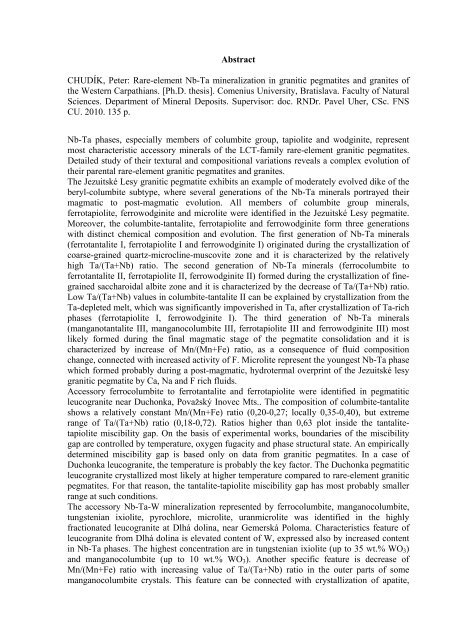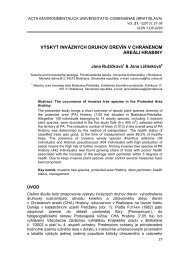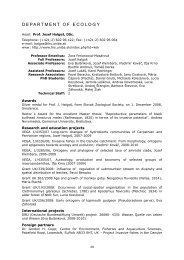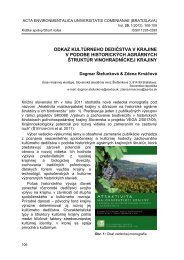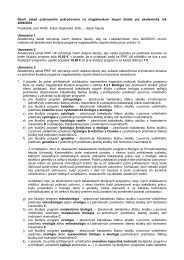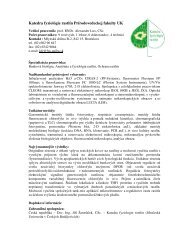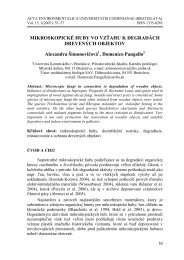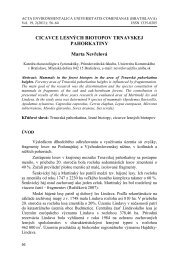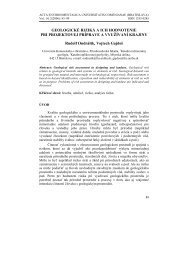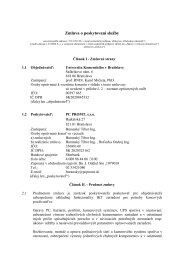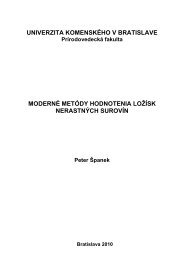UNIVERZITA KOMENSKÉHO V BRATISLAVE VZÁCNOPRVKOVÁ ...
UNIVERZITA KOMENSKÉHO V BRATISLAVE VZÁCNOPRVKOVÁ ...
UNIVERZITA KOMENSKÉHO V BRATISLAVE VZÁCNOPRVKOVÁ ...
Create successful ePaper yourself
Turn your PDF publications into a flip-book with our unique Google optimized e-Paper software.
Abstract<br />
CHUDÍK, Peter: Rare-element Nb-Ta mineralization in granitic pegmatites and granites of<br />
the Western Carpathians. [Ph.D. thesis]. Comenius University, Bratislava. Faculty of Natural<br />
Sciences. Department of Mineral Deposits. Supervisor: doc. RNDr. Pavel Uher, CSc. FNS<br />
CU. 2010. 135 p.<br />
Nb-Ta phases, especially members of columbite group, tapiolite and wodginite, represent<br />
most characteristic accessory minerals of the LCT-family rare-element granitic pegmatites.<br />
Detailed study of their textural and compositional variations reveals a complex evolution of<br />
their parental rare-element granitic pegmatites and granites.<br />
The Jezuitské Lesy granitic pegmatite exhibits an example of moderately evolved dike of the<br />
beryl-columbite subtype, where several generations of the Nb-Ta minerals portrayed their<br />
magmatic to post-magmatic evolution. All members of columbite group minerals,<br />
ferrotapiolite, ferrowodginite and microlite were identified in the Jezuitské Lesy pegmatite.<br />
Moreover, the columbite-tantalite, ferrotapiolite and ferrowodginite form three generations<br />
with distinct chemical composition and evolution. The first generation of Nb-Ta minerals<br />
(ferrotantalite I, ferrotapiolite I and ferrowodginite I) originated during the crystallization of<br />
coarse-grained quartz-microcline-muscovite zone and it is characterized by the relatively<br />
high Ta/(Ta+Nb) ratio. The second generation of Nb-Ta minerals (ferrocolumbite to<br />
ferrotantalite II, ferrotapiolite II, ferrowodginite II) formed during the crystallization of finegrained<br />
saccharoidal albite zone and it is characterized by the decrease of Ta/(Ta+Nb) ratio.<br />
Low Ta/(Ta+Nb) values in columbite-tantalite II can be explained by crystallization from the<br />
Ta-depleted melt, which was significantly impoverished in Ta, after crystallization of Ta-rich<br />
phases (ferrotapiolite I, ferrowodginite I). The third generation of Nb-Ta minerals<br />
(manganotantalite III, manganocolumbite III, ferrotapiolite III and ferrowodginite III) most<br />
likely formed during the final magmatic stage of the pegmatite consolidation and it is<br />
characterized by increase of Mn/(Mn+Fe) ratio, as a consequence of fluid composition<br />
change, connected with increased activity of F. Microlite represent the youngest Nb-Ta phase<br />
which formed probably during a post-magmatic, hydrotermal overprint of the Jezuitské lesy<br />
granitic pegmatite by Ca, Na and F rich fluids.<br />
Accessory ferrocolumbite to ferrotantalite and ferrotapiolite were identified in pegmatitic<br />
leucogranite near Duchonka, Považský Inovec Mts.. The composition of columbite-tantalite<br />
shows a relatively constant Mn/(Mn+Fe) ratio (0,20-0,27; locally 0,35-0,40), but extreme<br />
range of Ta/(Ta+Nb) ratio (0,18-0,72). Ratios higher than 0,63 plot inside the tantalitetapiolite<br />
miscibility gap. On the basis of experimental works, boundaries of the miscibility<br />
gap are controlled by temperature, oxygen fugacity and phase structural state. An empirically<br />
determined miscibility gap is based only on data from granitic pegmatites. In a case of<br />
Duchonka leucogranite, the temperature is probably the key factor. The Duchonka pegmatitic<br />
leucogranite crystallized most likely at higher temperature compared to rare-element granitic<br />
pegmatites. For that reason, the tantalite-tapiolite miscibility gap has most probably smaller<br />
range at such conditions.<br />
The accessory Nb-Ta-W mineralization represented by ferrocolumbite, manganocolumbite,<br />
tungstenian ixiolite, pyrochlore, microlite, uranmicrolite was identified in the highly<br />
fractionated leucogranite at Dlhá dolina, near Gemerská Poloma. Characteristics feature of<br />
leucogranite from Dlhá dolina is elevated content of W, expressed also by increased content<br />
in Nb-Ta phases. The highest concentration are in tungstenian ixiolite (up to 35 wt.% WO3)<br />
and manganocolumbite (up to 10 wt.% WO3). Another specific feature is decrease of<br />
Mn/(Mn+Fe) ratio with increasing value of Ta/(Ta+Nb) ratio in the outer parts of some<br />
manganocolumbite crystals. This feature can be connected with crystallization of apatite,


